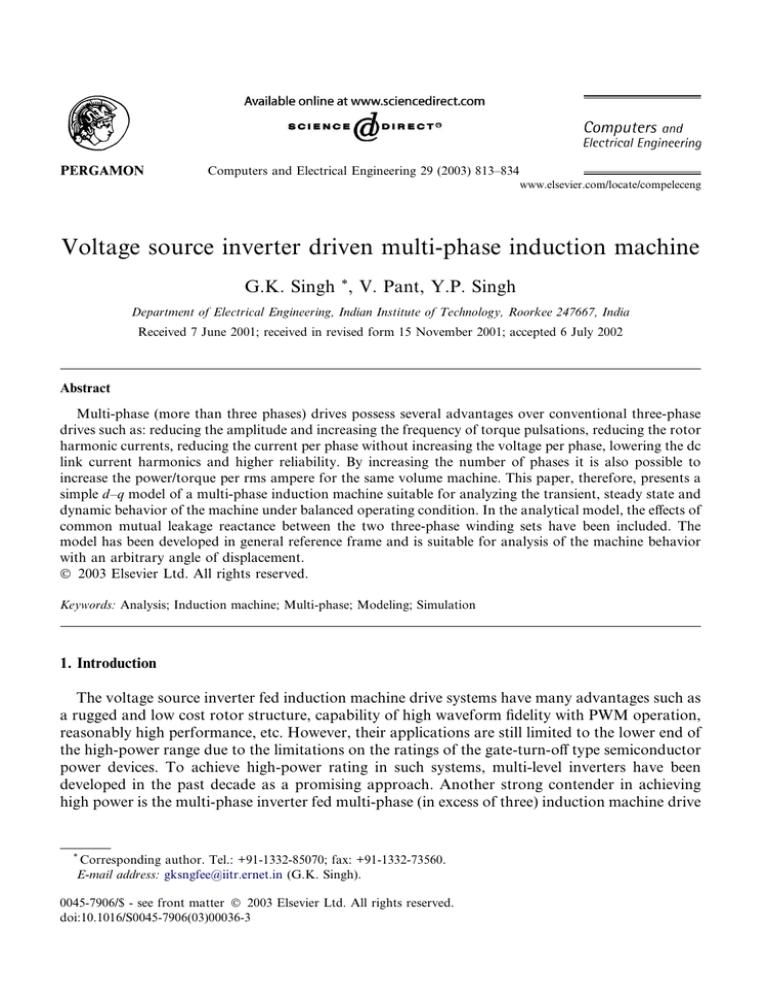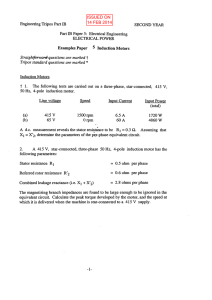
Computers and Electrical Engineering 29 (2003) 813–834
www.elsevier.com/locate/compeleceng
Voltage source inverter driven multi-phase induction machine
G.K. Singh *, V. Pant, Y.P. Singh
Department of Electrical Engineering, Indian Institute of Technology, Roorkee 247667, India
Received 7 June 2001; received in revised form 15 November 2001; accepted 6 July 2002
Abstract
Multi-phase (more than three phases) drives possess several advantages over conventional three-phase
drives such as: reducing the amplitude and increasing the frequency of torque pulsations, reducing the rotor
harmonic currents, reducing the current per phase without increasing the voltage per phase, lowering the dc
link current harmonics and higher reliability. By increasing the number of phases it is also possible to
increase the power/torque per rms ampere for the same volume machine. This paper, therefore, presents a
simple d–q model of a multi-phase induction machine suitable for analyzing the transient, steady state and
dynamic behavior of the machine under balanced operating condition. In the analytical model, the effects of
common mutual leakage reactance between the two three-phase winding sets have been included. The
model has been developed in general reference frame and is suitable for analysis of the machine behavior
with an arbitrary angle of displacement.
Ó 2003 Elsevier Ltd. All rights reserved.
Keywords: Analysis; Induction machine; Multi-phase; Modeling; Simulation
1. Introduction
The voltage source inverter fed induction machine drive systems have many advantages such as
a rugged and low cost rotor structure, capability of high waveform fidelity with PWM operation,
reasonably high performance, etc. However, their applications are still limited to the lower end of
the high-power range due to the limitations on the ratings of the gate-turn-off type semiconductor
power devices. To achieve high-power rating in such systems, multi-level inverters have been
developed in the past decade as a promising approach. Another strong contender in achieving
high power is the multi-phase inverter fed multi-phase (in excess of three) induction machine drive
*
Corresponding author. Tel.: +91-1332-85070; fax: +91-1332-73560.
E-mail address: gksngfee@iitr.ernet.in (G.K. Singh).
0045-7906/$ - see front matter Ó 2003 Elsevier Ltd. All rights reserved.
doi:10.1016/S0045-7906(03)00036-3
814
G.K. Singh et al. / Computers and Electrical Engineering 29 (2003) 813–834
Nomenclature
Tl
load torque
P
number of poles
J
moment of inertia
base speed
xb
speed of the reference frame
xk
speed of the rotor
xr
p
differentiation w.r.t. time
vq1 ; vd1 q- and d-axis voltages of stator winding set I
vq2 ; vd2 q- and d-axis voltages of stator winding set II
kq1 ; kd1 q- and d-axis stator flux linkages of set I
kq2 ; kd2 q- and d-axis stator flux linkages of set II
k0qr ; k0dr q- and d-axis rotor flux linkages referred to stator
iq1 ; id1 q- and d-axis currents of stator winding set I
iq2 ; id2 q- and d-axis currents of stator winding set II
stator per phase resistance of set I
r1
stator per phase resistance of set II
r2
rotor per phase resistance referred to stator
rr0
common mutual leakage inductance between the two stator winding sets
L0lm
mutual inductance between stator and rotor
Lm
leakage inductance per phase of stator winding set I
Ll1
leakage inductance per phase of stator winding set II
Ll2
leakage inductance per phase of rotor winding referred to stator
L0lr
0
common mutual leakage reactance between the two stator winding sets
xlm
mutual reactance between stator and rotor
xm
leakage reactance per phase of stator winding set I
xl1
leakage reactance per phase of stator winding set II
xl2
0
leakage reactance per phase of rotor winding referred to stator
xlr
mutual between the d- and q-axis circuit of the stator windings
L0ldq
v0qr ; v0dr q- and d-axis rotor voltages referred to stator
system. In addition to enhancing the power rating, a multi-phase system also has the merit of high
reliability at the system level [1–4]. In particular, with loss of one or more of stator winding excitation sets, a multi-phase induction machine can continue to be operated with an asymmetrical
winding structure and unbalanced excitation.
It is well known that the d–q–o reference frame transformation has long been used successfully
in the analysis and control of three-phase electric machines. In this approach, the original threedimensional vector space is decomposed into direct sum of a d–q subspace and a zero sequence
subspace, which is orthogonal to d–q. By virtue of this decomposition, the components, which
produce rotating m.m.f, and the components of zero sequence are totally decoupled, and thus the
analysis and control of machine is simplified.





